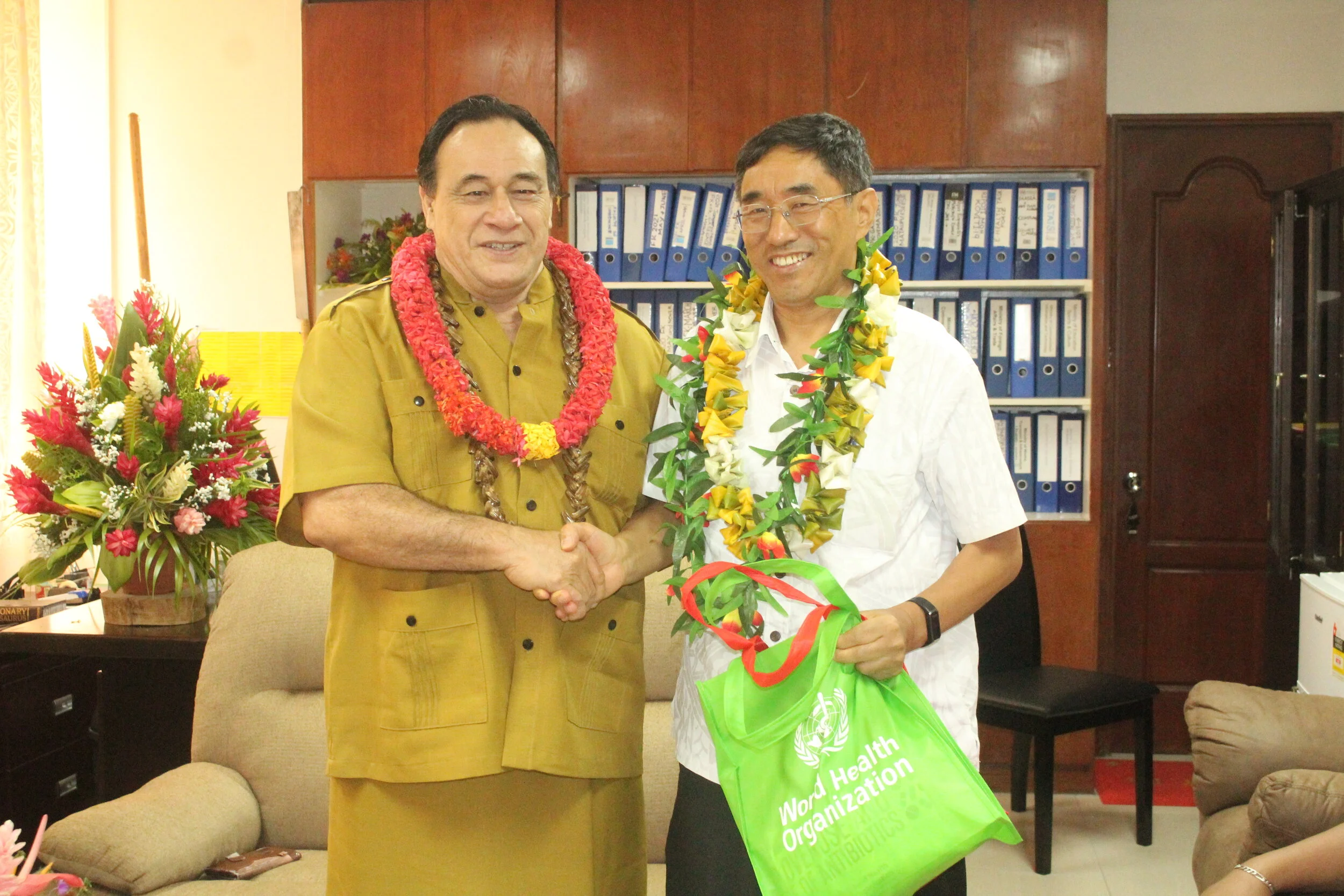MOH &: WHO REAFFIRMS COMMITMENTS FOR A HEALTHIER AND SAFER SAMOA
(GOVT PRESS SECRETARIAT);
The Minister of Heath, Afioga Valasi Luapitofanua Toogamaga Tafito Selesele today met with the World Health Organization (WHO)
representative for Samoa, Dr. Baoping Yang to reaffirm continued support and mutual collaboration between Government and WHO to further strengthen Health service delivery and Health system management in Samoa.
“I am grateful for the kind gesture and the support WHO has given to Samoa especially at the difficult times of COVID-19 pandemic, even the Measles in 2019 plus the fight against chronic diseases, NCD in particular,” acknowledged Health Minister Valasi andcontinued;
“The Government wishes to confirm our support for all the current health projects and interventions done and in progress. I am not here to make any new changes unless otherwise advised by our health experts. Our priority now is pushing our national immunization for our population.”
To further strengthen the mutual and beneficial partnership with WHO, the Health Minister also listed Samoa’s health priorities.
The list of priorities follows;
1. TO STRENGTHEN HEALTH SYSTEMS TOWARDS UHC
Participate in high-level policy dialogue on the pathway to achieving the Healthy Islands’ vision, Sustainable Development Goals and universal health coverage.
Support development of a framework for the institutionalization of health information and national health accounts for planning and resource allocation.
Amend legislation to provide opportunities for the implementation of Samoa’s E- Health Policy and Strategy (2016-2021).
Support improvements to the health information system through E-Health development, the Demographic and Health Survey and STEPS surveys.
Undertake analytical work for policy options for the revitalization of primary health care, and support for institutional development, including the proposed merger of National Health Services and the Ministry of Health.
Define and cost a standard service delivery package at village level, and for health centres and district hospitals.
Implement participatory conciliation and resolution mechanisms for medical errors and grievances.
Support the establishment of a pharmacovigilance system to improve the quality and safety of medicines.
Use health workforce projections to determine fellowship and training opportunities, including expanding Pacific Open Learning Health Network.
Support national health education and training institutions to achieve accreditation.
Promote a team approach to manage chronic patients through a partnership of doctors, nurses, allied health and community health workers, and patients and their families.
2. TO REDUCE AVOIDABLE DISEASE BURDEN AND PREMATURE DEATHS PARTICULARLY NCDS
Support evidenced-based best practice and surveillance for prevention, control and management of NCDs.
Review and develop a high-level multi-sectorial NCD strategy, with focus on controlling consumption of tobacco and alcohol and unhealthy diets.
Develop and implement legislative reforms including ratification of the WHO FCTC, restrictions on marketing of alcohol and unhealthy food to children, and increased excise taxes.
Scale up PEN Fa’a-Samoa geographically and horizontally, with improved links between community education, case detection and NCD case management and development of communications protocols used to address health literacy and self- management.
Update treatment guidelines and protocols across the continuum of care for management of cardiovascular diseases and diabetes, and integration of
rehabilitation and palliative care.
Involve traditional healers in the prevention and management of NCDs
Use the WHO Mental Health Gap Action Programme (mhGAP) to ensure patients with mental, neurological and substance use disorders are identified, assessed and managed through the system of referrals.
3. TO CONTROL COMMUNICABLE DISEASES AND PROTECT THE HEALTH OF WOMEN AND CHILDREN
Amend legislation to provide greater protection of children from exposure to unhealthy substances and behaviours, particularly in the education and home
environments.
Update treatment guidelines and protocols for management of STIs and HIV, TB and emerging diseases.
Conduct mass drug administration and transmission assessment surveys for the Lymphatic Filariasis Elimination Programme.
Improve capacity for planning and sustaining routine immunization and the introduction of new vaccines.
4. TO PROTECT SAMOAN PEOPLE FROM PUBLIC HEALTH EVENTS INCLUDING DISEASE OUTBREAKS.
Introduce and use Asia Pacific Strategy for Emerging Diseases and Public Health Emergencies III as a framework for building national capacity to detect, prepare for and respond to public health emergencies under International Health Regulations (2005).
Review and test disaster risk management plans through simulation exercises.
Continue to implement the National Action Plan for Antimicrobial Resistance including carrying out the annual Antibiotic Awareness Week and Hand hygiene Day and antimicrobial consumption surveys.

